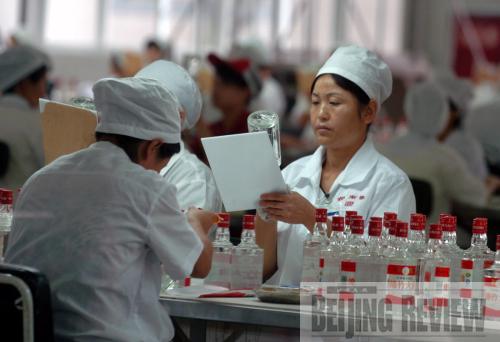|
 |
|
PRICE HIKES: Premium alcohol brands such as Moutai, Wuliangye and Jiannanchun raised prices by 3 to 10 percent to mitigate pressure from a recent alcohol tax increase (YUAN JIAN) |
Alcohol, rather than wine, is an indispensable component to Chinese table culture. The financial crisis has failed to affect white spirits sales, but an alcohol tax increase might.
China’s alcohol consumption taxation system consists of two different taxes—a low-level flat tax on all spirits, and an additional ad valorem tax levied on the price of the drink rather than on its content. Under the new regulation, effective as of August 1, the State Administration of Taxation raises ad valorem tax rates to 50 to 70 percent of the alcohol prices, up from 20 percent. Large liquor companies, meanwhile, will face particularly high ad valorem tax rates—some as high as 60 to 70 percent.
Now alcohol producers are faced with an important decision. The recent tax increases are about to seriously squeeze their profits —but should they raise prices and pass them along to customers in an already fiercely competitive market?
Different segments
Alcohol serves as a catalyst for social interactions between friends and family members and often facilitates negotiations between business partners in China. But, when people drink too much, it gives rise to problems like drunk driving accidents and domestic violence.
Because of these problems, many Chinese have voiced objections to alcohol abuse, and hope that price hikes will help cut consumption. But producers have responded differently to the tax increase.
Producers of premium white spirits brands all chose passing the tax increase along to customers. Sichuan Tuopai Alcohol Co. Ltd. announced it would increase prices of a series of products by 6.5 to 10 percent as of August 1. The Shanxi-based Fenjiu Group also increased prices by 5 to 25 percent. Price increases for premium alcohol brands such as Maotai, Wuliangye and Jiannanchun likewise ranged from 3 percent to 10 percent.
But low-end producers did not follow suit. Prices for their products in supermarkets remain almost unchanged.
An analysis by the China National Association for Liquor and Spirits Circulation (CNALS) said the high-end market enjoys stable demand, as buyers of high-end alcohol are mostly business people in negotiations or other business occasions. Family customers who are sensitive to prices, on the other hand, buy cheaper alcohol. In the low-end market where there is more competition, producers will avoid a price increase when possible.
Statistics from the CNALS reveal that China has more than 18,000 liquor producers. The industrial output of China’s alcohol industry stood at 146 billion yuan ($21.4 billion) in 2008, up 29.82 percent from the previous year. Aggregated profits reached 18 billion yuan ($2.6 billion) in 2008, up 36.79 percent year on year. High-end liquor enjoyed stable sales, while market share of low-end products increased remarkably to 58 percent in 2008 from 40 percent in 2007.
Liu Bin, Chairman of System Marketing Consulting Co. Ltd., said that under the tax increases, top-level alcohol distillers and brewers will speed up resource integrations within the industry—something that could affect second-tier producers with annual sales revenues ranging from 1 to 2 billion yuan ($146 - 292 million).
Whether enterprises could launch more effective—and successful—marketing campaigns, and continue to make money, is crucial to their survival since a vicious price war is no longer a clever idea to beat rivals, Liu said.
| 